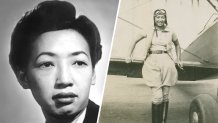
Hazel Ying Lee, one of the first Chinese American women to fly for the military after the Japanese attack on Pearl Harbor, was forced one day to make an emergency landing in a field in Texas when the engine of her training aircraft died.
She got out to see a farmer coming at her with a pitchfork, she told her fellow pilots that night on line in the mess hall at Avenger Field in Sweetwater.
He believed she was Japanese, recalled one of those pilots, Virginia Luttrell Krahn, in a 1997 oral history archived at Texas Women’s University’s Women’s Collection. “And Hazel said, 'No, I am an American. I am an American,'" Krahn recounted. The farmer didn't believe her.
He called his neighbors over and they surrounded her, certain she was a Japanese fighter and unable to believe that a Chinese American woman could be flying for their side. A military official finally convinced them they were wrong and they let her go.
"(She) enjoyed the danger and doing something that was new to Chinese girls,” her sister, Frances Tong, said in “A Brief Flight: Hazel Ying Lee and the Women Who Flew Pursuit” a documentary about Lee’s life.
Lee became a pilot at a time of continued anti-Asian discrimination, when Japanese-Americans were being imprisoned in internment camps and Asians were still restricted from immigrating to the United States
A Passion for Flying
Hazel Ah Ying Lee was born in Portland, Oregon, in 1912 when there were few opportunities for Chinese American girls. But she had passion for flying and after graduating from high school, while working as an elevator operator at a downtown department store, she joined the Chinese Flying Club of Portland.
She earned her pilot’s license in 1932, then left for China to try to join the Chinese Air Force in the fight against Japan. As in the United States, women were not accepted so she instead took a military desk job and flew commercial flights. In 1938, she returned home and lived in New York, where she bought war materials for the Chinese government.
The Women Airforce Service Pilots was created in 1943, the merger of two earlier flying groups for women, with the purpose of delivering planes from factories to military bases and flying them between bases. The competition to join was stiff, with only 1,879 candidates accepted from among the 25,000 women who applied. Only 1,074 completed the WASP training, Lee among them, finishing at the end of the year.
That year too she married Louie Yen-chung, whom she had met while learning to fly in Portland and whom she called Cliff. He was now in the Chinese Air Force.
“KNOT TIED TODAY,” she wrote in a telegram. “CAVU FOR CLIFF AND ME,” using a pilots’ acronym for “ceiling and visibility unlimited.” After their wedding, he returned to China and, when she did not hear from him for six months, she thought he was dead or had been captured.
Blazing a Trail

The Federal Aviation Administration credits Lee as the first Chinese-American woman to fly for the military. Another Chinese-American woman, Margaret Gee of California, also flew with the WASPs, surviving the war and later becoming a scientist.
“Hazel was not what you would call the epitome of the Chinese woman,” Krahn said in her oral history interview. “She was tall, slender and she had her hair cropped very short. She spoke very abruptly, very quickly, more masculine than feminine. She was hysterical.”
(While Krahn recalls Lee describing being chased by the farmer with the pitchfork, Lee wrote a much tamer version of the encounter for the "The Avenger," the WASP newspaper, according to Sandra Edwards Spears of the National WASP WWII Museum. The farmer and his wife arrived with a pitchfork, but he asked: "‘Are you China gal or Japanese gal?’” Spears told NBC News. “She said, ‘I’m China gal, sir. And he said, ‘Dag gummit, girl. You sure made a pretty landing.’”)
Lee was stoic and fearless, according to various profiles. She went on to join an even more elite group: one of 132 pilots to fly fighter aircraft, then known as pursuit airplanes. Among her jobs was to ferry new Bell P-63 Kingcobra fighters from the factory near Buffalo, New York, to Great Falls, Montana. From there, the planes were flown to Alaska and turned over to allied Russian pilots.
The Last Flight
On her last flight, on Thanksgiving Day in November 1944, Lee was among a group of pilots arriving in Great Falls. Krahn was too, and after she had landed safely, she saw two planes too close together at the end of the runway. The one on top was piloted by Jeff Russell, whose radio was not working, the other by Lee.
“When the tower saw what was happening they said 'pull up, pull up,'” Krahn remembered. “And the only plane that could hear it was Hazel. And she pulled up right into Jeff who heard nothing of course.”
Both planes caught fire and although Russell escaped with only an injured foot, Lee was trapped in her plane and burned badly. She died two days later.
“She was conscious the entire time,” Krahn said. “The doctor said they had never seen anyone so brave. She never complained.”
She was the last WASP to die flying during the war, 38 in all. Her husband, meanwhile, had survived.
She and her brother, Victor, who was killed around the same time in France while serving in the U.S. Tank Corps in France, were buried together in a Portland cemetery. The cemetery at first told the family that Asians were not permitted in the white section.

